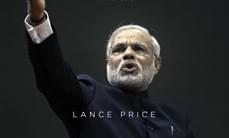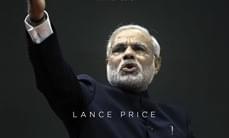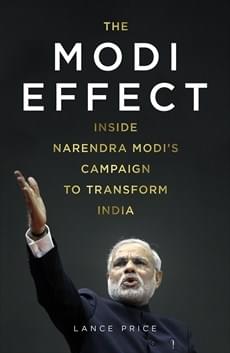Politics
The Modi Effect
Amarnath Govindarajan
Apr 23, 2015, 04:07 PM | Updated Feb 11, 2016, 09:12 AM IST
Save & read from anywhere!
Bookmark stories for easy access on any device or the Swarajya app.


Lance Price, former BBC correspondent and Downing Street communications expert, had been granted exclusive access to Prime Minister Narendra Modi to analyse the campaign that brought the latter to power.
In the following excerpt chosen from his book The Modi Effect, Price discusses Modi and Rahul Gandhi, and their contrasting attitude towards online and social media communication in the run-up to the 2014 Lok Sabha elections.
The Modi Effect: Inside Narendra Modi’s Campaign To Transform India, Lance Price, Hodder & Stoughton (15 March 2015).
Narendra Modi is an early riser. He is awake before dawn and soon ready for the yoga and meditation routines that help prepare him mentally, physically and spiritually for the day ahead. Before he settles into position to follow an exercise regime that has its roots in centuries of Indian tradition, however, he has a more contemporary reflex that will not wait. He connects to the internet.
‘Yes I do have the habit of doing this,’ he told me. ‘I am up daily by five a.m. and do not need any time to settle down before I am online checking my messages. It’s a mechanical process now for me to reach out for my iPad within the first four to five minutes after I wake. Likewise every day before I go to bed I take a look at my emails and check any relevant news that I may not have heard about and want to read. Honestly, I never take breaks and never really switch off.’
His internet habit started, he said, as long ago as the late 1990s, when he was effectively in political exile from his native Gujarat. He discovered, it was the best way to keep in touch with what was happening back home and he has been obsessed with keeping up with the latest online applications ever since. So much so that it has often been Modi who introduced his younger staff to the latest technology.
‘I was seen as very tech savvy from the early days and was the first to use a digital camera in the 1999 elections.’
As chief minister from 2001 onwards he consistently tried to stay ahead of the game.
‘Another example of my forward thinking relevant to the technology world is my prediction around WhatsApp. When WhatsApp had just started, and long before it had become popular I was telling my people to start using this as a means for communication as it would be a major messaging platform in the days to come’.
Modi signed up on Facebook and Twitter in 2009, and from a slow start his number of ‘friends’ and followers grew steadily. One of the skills he looked for in the young men he recruited at that time was their ability to use social media to its best effect. One recalled, ‘It was our very first meeting and he asked how he could double his Facebook likes.’ His enthusiasm for online communication caught the attention of the BJP’s national head of IT in Delhi.
Arvind Gupta had been trying to persuade the party leadership that it had to start moving with the times. Having worked in both Silicon Valley in California and India’s own IT capital, Bangalore, he joined the party stuff full time in early 2010 and said that the BJP was barely in the game when it came to online campaigning.
‘I said, you can’t just start doing these things three months before the election. We needed a structured approach, collecting data, using that data effectively, engagement with people over the long term so you are not just engaging with your volunteers and your voters just ad hoc before the elections. If you do that your brand loyalty, if I can call it that, becomes much higher.’
To Gupta it seemed that Modi was alone among the party’s top names in understanding the potential. ‘Yes, he was the only one. He understood the power of the medium’.

Rahul Gandhi was twenty years Modi’s junior. He had spent a lot of time outside India, going to college first in Florida and then in Cambridge, and afterwards working as a management consultant in London. Yet he thought he knew how Indian politics worked better than the man [Modi] who had spent his whole life travelling around the country.
One communications expert, who was later recruited to Team Modi, said he and his colleagues first approached Gandhi and offered to work for him. ‘We had some common friends so we had an interaction with Rahul,’ he told me. ‘We were young chaps, very excited to meet him. Here was the next-generation leader who we thought could use social media to communicate. I said to him, let’s do it. Let’s reach out to the people and you can change the country. But he said no, that the real India does not live in the online world. I was, like, what? He said you are all urban guys, you think it’s all about urban India but this is a poor country. He gave us this socialist speech. So I walked away disillusioned. I didn’t go to him for political philosophy, I went as a youngster so I was very disappointed.
I met Modi a year after that and at once I thought, this guy speaks my language.’
While it is true that in parts of rural India there is still no electricity, never mind a usable internet connection, it was estimated that over 240 million people were online by the middle of 2014, with a year-on –year increase of around 28%. Of those, 185 million were connecting via their mobile phones. So while Rahul Gandhi was right to say that not all Indians were ready to get the message via social media, many were, and those who did would often pass on what they had learned to friends, relatives and neighbours by word of mouth.
The BJP divided the country’s 543 constituencies approximately into thirds. ‘There were three elections happening at the same time,’ according to one of the team. ‘There was a pre-modern election in about two hundred seats which didn’t require a social media campaign at all. Then there was the modern election, which would include semi-urban towns. And finally we identified one hundred and fifty-five constituencies that could be said to be involved in a digital election.’ And use of the internet was not just about disseminating party propaganda or recruiting volunteers.
It was a two-way process, with the IT cell in Delhi and the many freelance operators out in the ecosystem using the web to pick up intelligence about what was going on and what people were saying, documenting it all in a specially created ‘National Digital Operations Cell’ or N-Doc, and then passing it on to the Modi ground operation.
The purpose of the digital campaign was not merely to increase his number of ‘likes’ or Twitter followers, although he would eventually accumulate over 14 million Facebook fans, second only to Obama as a political leader. Almost one in six of all Facebook users in India were following Modi by the end of the campaign. But the real objective was to turn ‘likes’ into votes.
For those involved in it, the digital campaign was both exciting and challenging. The excitement kept hundreds if not thousands of enthusiastic young volunteers busy for months. ‘The challenge’, in Modi’s own words, ‘was there was no campaign before on this scale using social media and technology that had been managed anywhere in the world and hence we had no comparative basis from which to learn’.
Every conceivable online platform was exploited including BuzzFeed, Pinterest, Tumblr and StumbleUpon, which I have to confess I had never stumbled upon, but clearly more avid internet users than me had. Banner ads went up in a multitude of languages, and users were encouraged to interact as much as possible.
They could use their mouse and cursor to ‘rub off’ whatever bugged them most, like corruption or underdevelopment, and discover who had the solution to their problems underneath. There is no need for me to reveal who that turned out to be. And as the ‘selfie’ craze gathered momentum, anybody who chose to could submit a selfie of their own and see it form part of a huge mosaic of similar photos that formed an image of you-know-who. #SelfieWithModi was the top trending hashtag on social media within two minutes of its launch, not just in India, but worldwide.




